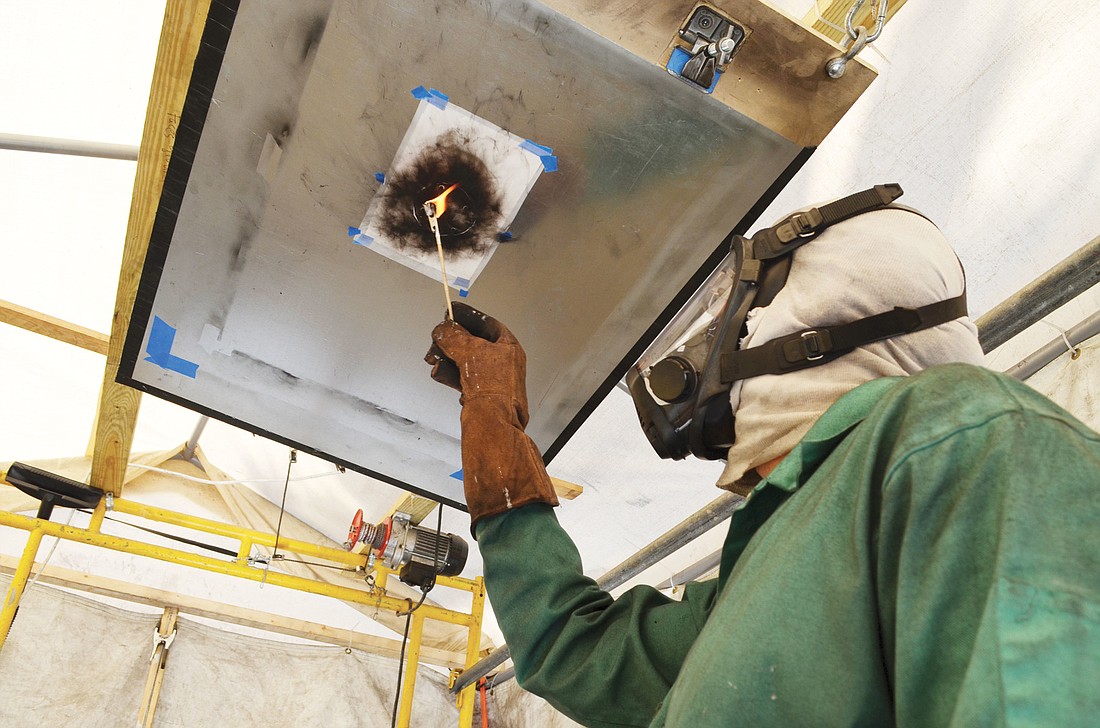- May 9, 2024
-
-
Loading

Loading

A canvas extends from the ceiling of a tent at an angle over artist Rob Tarbell’s head. In one hand, the newly Sarasota-based artist holds a kebab skewer with an alligator clip attached to the tip. The clip clamps a plastic grocery store membership card cut into rectangular pieces the size of a fingernail.
Tarbell uses the plastic rewards and membership cards that accumulate in one’s wallet and lights them on fire. Other times, he’ll burn old 35-millimeter photo slides. He uses the smoke to create art.
Today’s credit card smoke billows above to the canvas. He creates an image by covering and uncovering portions of translucent tracing paper lying on top of the canvas (similar to a stencil) and by manipulating the angles of the canvas. Contrary to the surrealist method of fumage that uses a candle to burn places of the canvas, Tarbell layers the soot.
The longer he exposes the naked portions of canvas to smoke, the darker the area becomes. Sometimes the smoke sneaks onto portions of the canvas he’s been hiding, but he doesn’t mind. Tarbell finds beauty in trying to control the uncontrollable.
Tarbell is like the smoke; he’s always done things his own way, even when in his life someone has tried to make him think traditionally. For instance, in grade school he took group art lessons at the Cleveland Art Institute. The teachers directed the students to draw a cast of Rodin’s “The Thinker.”
“But I wanted to draw underwater fish scenes,” Tarbell says. “They’d say, ‘We’re doing this,’ and I’d say, ‘No! Check out this underwater bass eating a fish.’ I guess that bleeds into how I do what I want now.”
Tarbell was traditionally trained up to a graduate-degree level of painting, but he never used traditional methods or mediums. Before his painted work went up in smoke, he painted with varnish, typically used as a protective finish, that he’d enhance with color pigment.
He likes using methods or mediums that are hard to control because he says it always puts him in the place of being a learner. With paint, there were already masters that led the way in teaching generations how to manipulate it. With smoke, Tarbell figured it out. No one taught him.
“It’s fun to just gauge what’s going to happen,” he says. “… that constant figuring it out of, ‘How can I make this work.?”
He sites a few inspirations for his self-created medium. The idea started forming when, on a visit to Italy, Tarbell learned about the accumulation of smoke on the ceiling of the Sistine Chapel. He also attempted creating a portrait of his friends who smoked and drank a lot using smoke from unfiltered Lucky Strikes that went horribly wrong. The smoke didn’t accumulate. That’s when he decided to burn and make use of those membership cards fattening up his wallet — that was nearly 10 years ago.
Since the early days, he’s had a few fiery incidents when the canvas has caught ablaze and burned up his art. He wears shorts — because he learned he could feel if something is on fire before he can necessarily see the fire — in addition to a gas mask with an air filtration unit to prevent inhaling the toxic fumes.
Right now, he’s working in a tent set up at a warehouse studio space located near Booker High School. It’s temporary.
He and his wife, Anna VanGehr, moved to Sarasota from Charlottesville, Va., in June 2013 for her new job at The Ringling. They’ll settle into a new home with a built-on studio at the end of May.
Since coming here, Tarbell hasn’t started any new pieces. He’s instead focusing on finishing ones he started in Virginia. He made his Sarasota debut when Allyn Gallup Contemporary Art featured a couple of his pieces in its “Made in Sarasota” show.
Tarbell says Sarasota is probably the friendliest place he’s ever lived. The natural lighting here is unique.
“They say it takes two years for a new place’s influence to have an effect,” he says. “I imagine it will be in the use of light.”